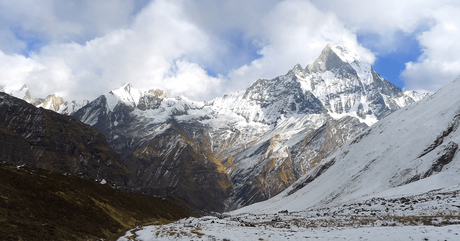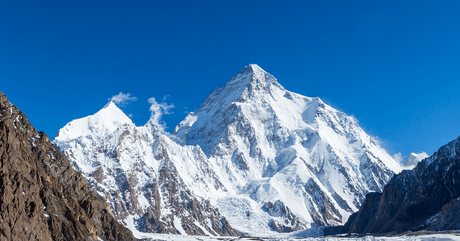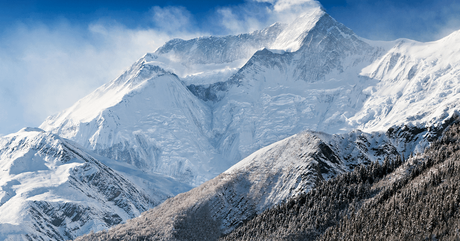Which is more dangerous: Annapurna or K2? Mountaineers have long debated this question, and there is no easy answer. Each mountain has its own dangers, and climbers must be prepared for anything if they hope to reach the summit. In this article, we will compare and contrast the two mountains, looking at their similarities and differences. We will also consider the risks involved in climbing each one. By the end of this article, you should have a better understanding of which mountain is more dangerous—and why.
Mount Annapurna
Annapurna is an abbreviated form of the Sanskrit words anna (food) and pūrṇa (full), meaning “Goddess of the Harvest”. Nepali historian Mani Ratna Tuladhar first used the name in a Hindu purāṇa (religious text) called Skanda Purana.
This text describes the goddess Annapurna as Shiva’s wife and Ganesha’s mother.
The Annapurna massif is located in the Himalayas in Nepal and includes several peaks over 8,000 meters (26,247 feet). The highest peak in the massif is Annapurna I, which stands at 8,091 meters (26,545 feet). Annapurna I is the tenth-highest mountain in the world.

The first recorded attempt to climb Annapurna I was made by a French expedition in 1950. The expedition was led by Maurice Herzog, and it included Lionel Terray, Gaston Rébuffat, and Marcel Ichac. On June 3, 1950, Herzog and Terray became the first people to reach the summit of Annapurna I.
Since that time, an estimated 365 people have climbed Annapurna I, and about two-thirds of those climbers have been successful. However, the mountain has also claimed the lives of many climbers. As of 2022, there had been 72 recorded deaths on Annapurna I, making it the deadliest of the eight-thousanders (mountains that are taller than 8,000 meters).
Mount K2
K2 is the second-highest mountain in the world, after Mount Everest. It is located in the Himalayas on the border between Pakistan and China. The mountain was first surveyed by a European expedition in 1856, led by British surveyor George Alywn Glascock. However, it was not until 1892 that a German expedition led by Oscar Eckenstein attempted to climb the mountain.

Eckenstein’s expedition was unsuccessful, but it did manage to reach a height of about 6,700 meters (22,000 feet). In 1902, another German expedition, this time led by Willy Merkl, made it to 7,200 meters (23,622 feet). It was not until 1954 that anyone reached the summit of K2.
On July 31, 1954, an Italian expedition led by Ardito Desio became the first people to stand on top of the mountain. The team included Rita Meroi, Lino Lacedelli, Achille Compagnoni, and Walter Bonatti.
As of 2022, there have been 377 people who have reached the top of K2. However, 91 climbers have perished while attempting to go higher.
Annapurna or K2: Which is more dangerous?
Annapurna, the world’s 10th highest mountain, is actually more dangerous to climb than K2, the world’s 2nd highest mountain. In fact, Annapurna has been nicknamed “the killer mountain” because it has the highest fatality rate of any 8,000 meter peak, with one in four climbers dying on the mountain.
So what makes Annapurna so dangerous? There are a few factors. First, the weather in Annapurna is notoriously unpredictable and can change very quickly. This can make conditions on the mountain very difficult to assess and can lead climbers into dangerous situations.
Second, the route to the summit of Annapurna is particularly treacherous, with a number of steep, exposed sections. This makes it easy for climbers to lose their footing and fall.
Finally, the altitude of Annapurna means that climbers can experience altitude sickness more easily than on other mountains. This can lead to disorientation and confusion, which can be dangerous in an already treacherous environment.
Fatality Rate
According to NASA, approximately 25% of climbers die while attempting to climb K2 where as approximately 32% of climbers die while attempting to climb Annapurna I. So, even though more people have died on K2, Annapurna’s fatality rate is actually higher.
The Risks Involved in Climbing Each Mountain
Climbing any mountain is a risky endeavor. However, certain risks are specific to each mountain.
On K2, the biggest risks come from avalanches and rockfalls. The route to the summit of K2 goes through the “ Bottleneck”, a narrow mountain section that is particularly prone to avalanches. In 2008, 11 climbers were killed in an avalanche in the Bottleneck.
On Mount Annapurna, the biggest risks come from Crevasses. A crevasse is a deep crack in the ice, and they can be very difficult to see. This makes them very dangerous for climbers, as they can easily fall into one and be seriously injured or killed.
Why do people still climb Annapurna?
Despite its dangers, Annapurna continues to be a popular mountain to climb. Part of the reason is that it is one of the few 8,000 meter peaks that can be climbed without the use of supplemental oxygen. This makes it a bit more accessible to climbers than some of the other high peaks.

Another reason is that the views from the summit of Annapurna are truly breathtaking. The mountain sits in the middle of a massive valley, and on a clear day, climbers can see for miles in every direction.
So even though it is dangerous, Annapurna remains an enticing challenge for mountaineers worldwide.
Conclusion
Both K2 and Annapurna are dangerous mountains to climb. However, Annapurna is actually more dangerous than K2, with a higher fatality rate. This is due to a number of factors, including the unpredictable weather, treacherous routes, and the high altitude. Climbing any mountain is risky, but those who choose to climb Annapurna and k2 must be aware of the dangers involved.
